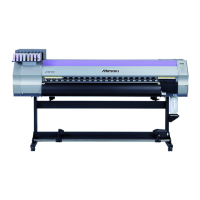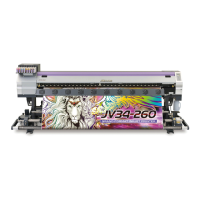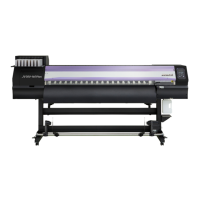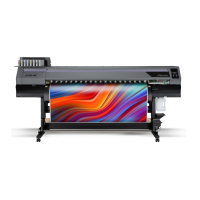



Do you have a question about the MIMAKI JV33 Series and is the answer not in the manual?
Lists necessary tools for printer maintenance.
Details cleaning the sensitive areas around the printer heads.
Explains how to clean the capping station to prevent ink buildup.
Describes the process for cleaning or replacing the printer wiper.
Discusses cleaning dust accumulation on the media press mechanism.
Details cleaning the media sensors to ensure accurate media detection.
Advises on cleaning the platen where dust and ink can accumulate.
Instructions for cleaning the external surfaces of the printer unit.
Guidance on checking and managing the waste ink tank status.
Performing basic cleaning as a first step in recovery.
Standard procedure for cleaning the print head to resolve issues.
Advanced head cleaning for persistent nozzle problems.
Specific nozzle cleaning with a defined dwell time for cleaning liquid.
Repeating nozzle cleaning with an extended dwell time.
Cleaning the ink flow path to clear blockages.
Refilling ink lines to restore proper ink flow.
Lists necessary tools for printer maintenance.
Details cleaning the sensitive areas around the printer heads.
Explains how to clean the capping station to prevent ink buildup.
Describes the process for cleaning or replacing the printer wiper.
Discusses cleaning dust accumulation on the media press mechanism.
Details cleaning the media sensors to ensure accurate media detection.
Advises on cleaning the platen where dust and ink can accumulate.
Instructions for cleaning the external surfaces of the printer unit.
Guidance on checking and managing the waste ink tank status.
Performing basic cleaning as a first step in recovery.
Standard procedure for cleaning the print head to resolve issues.
Advanced head cleaning for persistent nozzle problems.
Specific nozzle cleaning with a defined dwell time for cleaning liquid.
Repeating nozzle cleaning with an extended dwell time.
Cleaning the ink flow path to clear blockages.
Refilling ink lines to restore proper ink flow.
| Print Technology | Piezo inkjet |
|---|---|
| Ink Type | Solvent ink |
| Print Head | On-demand piezo head |
| Resolution | 1440 dpi |
| Print Speed | Up to 17.5 m²/h |
| Ink Colors | CMYK |
| Media Thickness | 1 mm |
| Media Handling | Roll media |
| Interface | USB 2.0 |
| Maximum Print Width | 1, 610 mm (63.4") |












